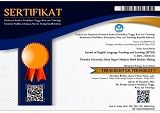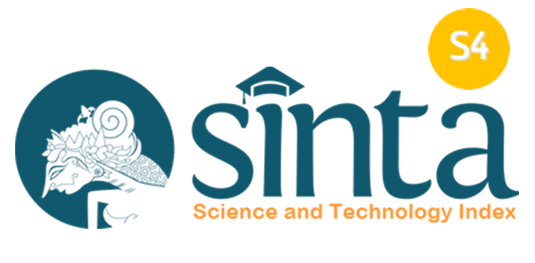Exploring factors influencing phonological errors of Indonesian EFL students
Abstract
Keywords
Full Text:
PDFReferences
Adawiah, R., & Muliati, A. (2024). The effect of Elsa Speak application on students’ English pronunciation development. Journal of Excellence in English Language Education, 3(1), 65–70. https://ojs.unm.ac.id/JoEELE/article/view/59627
Alsalihi, H. D. (2020). Main difficulties faced by EFL Students in Language Learning. Journal of College of Education for Women, 31(June 2020), 19–34. https://doi.org/10.36231/coedw.v31i2.1359
Andi-Pallawa, B., & Fiptar Abdi Alam, A. (2013). A comparative analysis between English and Indonesian phonological systems. International Journal of English Language Education, 1(3). https://doi.org/10.5296/ijele.v1i3.3892
Anwar, Y., & Kalisa, P. (2020). Students’ problems in pronouncing non-existing English diphthongs in Indonesian language. Language Circle: Journal of Language and Literature, 15(1), 17–25. https://doi.org/10.15294/lc.v15i1.26261
Ariati, J. (2020). Analysing reading skill in national plus school curriculum: Phonological awareness of young learners. REiLA : Journal of Research and Innovation in Language, 2(2), 70–75. https://doi.org/10.31849/reila.v2i2.4007
Arjulayana, A. (2016). Indonesian students’ learning style in English speaking skill. Jurnal Dinamika UMT, 1(2), 1. https://doi.org/10.31000/dinamika.v1i2.574
Ashcraft, A. (2023). Effects of socioeconomic status on English language learners’ success in school. M.Ed. Literature Reviews, 19, 1–62. https://digitalcommons.tacoma.uw.edu/med_theses
Buana, T. S., & Irawan, L. A. (2021). Students’ phonological awareness and their strategy in pronuncing words. Journal of Language and Literature Studies, 1(1), 51–56. https://doi.org/10.36312/jolls.v1i1.528
Chard, D. J., & Dickson, S. V. (1999). Phonological awareness: Instructional and assessment guidelines. Intervention in School and Clinic, 34(5), 261–270. https://doi.org/10.1177/105345129903400502
Dangin, & Wijayanti, N. (2018). The study of English phonological errors of advanced second language learners in pronouncing similarly-spelled words. Lire Journal: Journal of Linguistics and Literature, 2(1), 30–34. https://doi.org/https://doi.org/10.33019/lire.v2i1.20
Nokas, D. N. (2021). Students' ability in using personal pronouns in English. Journal of English Teaching and Language (JETLE), 3(1), 20-27. https://doi.org/10.18860/jetle.v3i1.13129
Ellis, R. (1997). EBOOK_Second_Language_Acquisition_by_Ro. Oxford University.
Fauzan, U. (2019). Buku ajar sociolinguistics (Riinawati (ed.)). CV. KANHAYA KARYA. www.kakapress.web.id
Hafizha, A., Fauziah, H. A., & Lubis, Y. (2023). Difficulties faced by English language students in phonology courses. Sinar Dunia: Jurnal Riset Sosial Humaniora Dan Ilmu Pendidikan, 2(3), 37–46.
Hamka. (2016). Phonetics and phonology in teaching English as the theory of language production. Proceedings of the Fourth International Seminar OnEnglish Language and Teaching (ISELT-4), 04(01), 348–362. https://doi.org/10.1017/s0272263105220284
Hellmich, S. N. (2017). What is socioeconomics? An overview of theories, methods, and themes in the field. Forum for Social Economics, 46(1), 3–25. https://doi.org/10.1080/07360932.2014.999696
Hibatullah, O. F. (2019). The challenges of international EFL students to learn English in a non-English speaking country. Journal of Foreign Languange Teaching and Learning, 4(2). https://doi.org/10.18196/ftl.4240
Khoirida, A., Setyaningsih, E., & Zainnuri, H. (2021). Exploring pronunciation teaching practice in emergency remote teaching: Lesson from Indonesian high school context. Eduvelop, 5(1), 1–12. https://doi.org/10.31605/eduvelop.v5i1.1187
Lanteigne, B. (2006). Common, persistent errors in English by Brazilian Portuguese speakers. TEFL Web Journal, 4(January 2006), 17.
Listyarini, A. A., Lintangsari, A. P., & Emaliana, I. (2022). The influence of English phonemic awareness to reading comprehension: A study on Indonesian EFL learners. JEES (Journal of English Educators Society), 7(1). https://doi.org/10.21070/jees.v7i1.1287
Nur, I., & Rahman, I. F. (2018). The use of minimal pair technique in teaching pronunciation at the second year students of SMAN 4 Bantimurung. ETERNAL (English, Teaching, Learning, and Research Journal), 4(2), 276. https://doi.org/10.24252/eternal.v42.2018.a11
Purnami, N. M. A., & Junipisa, N. M. E. (2023). Analysis of phonological errors in first semester students in performing self introduction a case study in institute level. Jurnal Pendidikan Glasser, 7(1), 57. https://doi.org/10.32529/glasser.v7i1.2215
Renaldi, A., Stefani, R. P., & Gulö, I. (2016). Phonological difficulties faced by students in learning English. Proceedings of the Fourth International Seminar on English Language and Teaching (ISELT 4), May, 97–100. https://doi.org/10.13140/RG.2.1.2233.1763
Rineapi, Triwardani Henni, & Nur Raysal. (2022). The effectiveness of ELSA Speak application to improve pronunciation ability. Jurnal Fakultas Keguruan & Ilmu Pendidikan, 3(1), 28–33.
Robah, A., & Anggrisia, N. F. (2023). Exploring challenges and strategies in English speaking among Indonesian university students: A case study of AKM university. Englisia: Journal of Language, Education, and Humanities, 11(1), 55–74.
Roepke, E., & Brosseau-Lapré, F. (2023). Speech error variability and phonological awareness in preschoolers. American Journal of Speech-Language Pathology, 32(1), 246–263. https://doi.org/10.1044/2022_AJSLP-22-00031
Sapta Nadilla, J., Anwar Korompot, C., & Ariyani, A. (2023). The correlation between students’ socioeconomic status and their motivation in learning English. Journal of Excellence in English Language Education, 2(1), 9–14.
Shaphitri, N. D., Putri, E. J., & Rahayu, T. (2022). Analysis of phonological errors in consonant /-t/ and /-d/ by English teachers in Indonesia. PROJECT (Professional Journal of English Education), 5(3), 563–574.
Suryani, L., Syahrizal, T., & El Fauziah, U. N. (2019). Using Orai application in teaching pronunciation. Indonesian EFL Journal, 5(2), 93. https://doi.org/10.25134/ieflj.v5i2.1835
Tiono, N. I., & Yostanto, A. M. (2008). A study of English Phonological errors produced by English department students. K@Ta, 10(1), 79–112. https://doi.org/10.9744/kata.10.1.79-112
Wardana, I. K., Astuti, P. S., & Sukanadi, N. L. (2022). Examining the effect of phonological awareness instruction on EFL learners’ pronunciation and motivation. Erudita: Journal of English Language Teaching, 2(2), 129–147. https://doi.org/10.28918/erudita.v2i2.6191
Wiese, R. (2006). Phonology: Overview. Encyclopedia of Language & Linguistics, December 2006, 562–564. https://doi.org/10.1016/b0-08-044854-2/00035-3
Zahira, M., & Andreani, S. (2023). The Phonemic awareness and reading comprehension of the second graders. Jurnal Bahasa Lingua Scientia, 15(2), 389–412. https://doi.org/10.21274/ls.2023.15.2.389-412
DOI: https://doi.org/10.18860/jetle.v6i1.27060
Refbacks
- There are currently no refbacks.
Jalan Gajayana 50 Malang 65144, Jawa Timur, Indonesia

This work is licensed under a Creative Commons Attribution-ShareAlike 4.0 International License.
Indexed by





